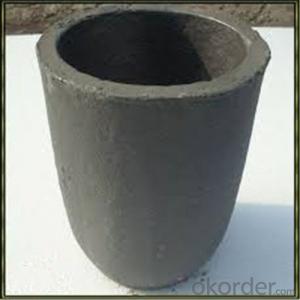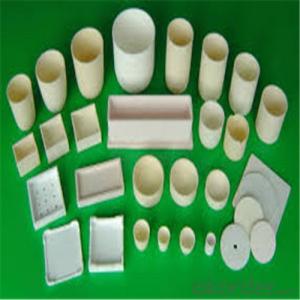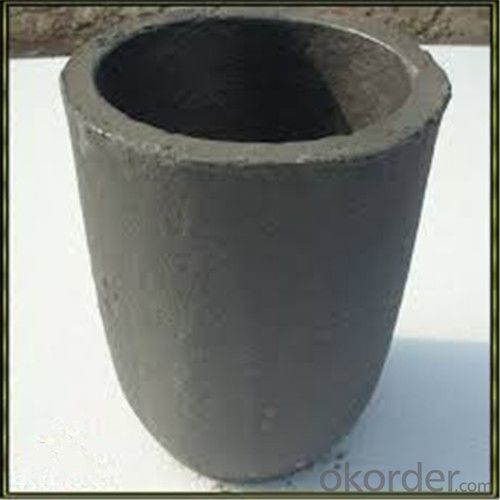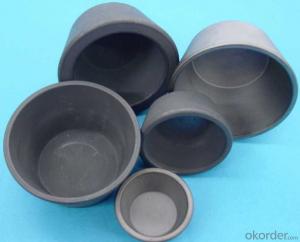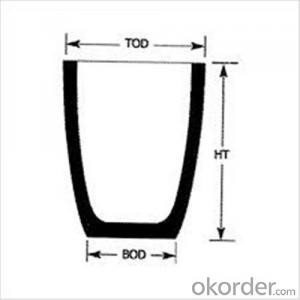High-Quality Crucible Graphite Metallurgy SIC Crucibles
- Loading Port:
- Shanghai
- Payment Terms:
- TT OR LC
- Min Order Qty:
- 1 pc
- Supply Capability:
- 1000 pc/month
OKorder Service Pledge
OKorder Financial Service
You Might Also Like
Quick Details for SiC Graphite Crucibles For Melting Aluminium And Copper, Brass
| Type: | High Strength, graphite crucible crucible | Application: | melting metal | Height: | as your requirements |
| Composition: | High Pure | Top Diameter: | 10-600mm | Bottom Diameter: | 10-1000mm |
| Place of Origin: | China (Mainland) | Brand Name: | Model Number: | ||
| Color: | Black grey | Si3N4%: | 5min | Fe2O3%: | 0.7max |
| C%: | 30-45 | Apparent porosity: | 30max | Refractoriness: | 1680 |
| Bulk Density: | 1.71min | Using life: | >5000 hours | MAX temperature: | 1600c |
Packaging & Delivery
| Packaging Details: | Seaworty packing or as per customer's detail requirement of graphite crucible. |
| Delivery Detail: | within 20-30 days after confirm order of graphite cru |
SiC Graphite Crucibles For Melting Aluminium And Copper, Brass
Product Description
Specifications for Graphite Silicon Carbide Crucible For Aluminum Melting :
1.Long working lifetime: its working lifetime is increased 3-5 times over normal clay-crucible due to the compact body formed under high pressure.
2.High thermal conductivity: high-density body and low apparent porosity greatly improve its heat conductivity.
3.New-style materials: new heat conduction material ensures faster heat conductivity and pollution-free product, reduces adherent slag.
4.Resistance to corrosion:better anti-corrosion than normal clay-crucible.
5.Resistance to oxidation: advanced process dramatically improves its oxidation resistance, which ensures persistent heat conductivity and long working lifetime.
6.High-strength: high-density body and logical structure make the product better compression property.
7.Eco-friendly: energy-efficient and pollution-free, not only ensure metal product purity, but also ensure sustainable development on environment.
8.Multi-function: Can be used in induction graphite crucible furnace
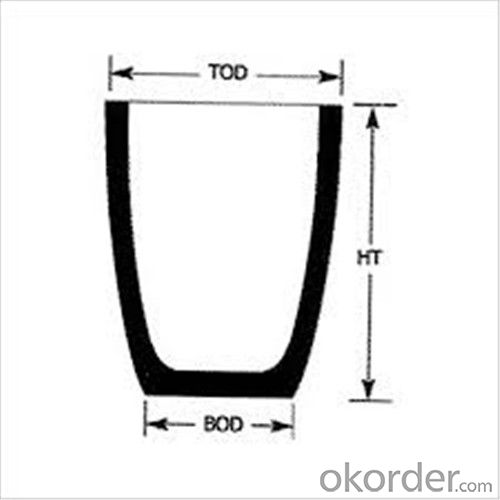

Physicochemical Properties of graphite crucible:
The crucible is an utensil or melting tank vessels that is made of refractory material (such as clay, graphite, quartz or difficult molten metal iron, etc.).
Graphite crucible, with is special advantages and Plasticity, is widely used in the smelting area, e.g. gold smelting, silver smelting, aluminum smelting, cooper smelting, etc.
high pure graphite | ||||
Item | Unit | baked twice | baked three time | baked four times |
impregnated once | impregnated twice | impregnated three times | ||
grain size | mm | ≤325μm | ≤325μm | ≤325μm |
Bulk density | g/cm3 | ≥1.68 | ≥1.78 | ≥1.85 |
Specific resistance | μΩ.m | ≤14 | ≤14 | ≤13 |
Bending strength | MPa | ≥25 | ≥40 | ≥45 |
Compressive strength | MPa | ≥50 | ≥60 | ≥65 |
Ash content | % | ≤0.15 | ≤0.1 | ≤0.05 |
Fine-grain Specialty Graphite FXG-1 | Fine-grain Specialty Graphite FXG-2 | ||||
Item | Unit | Guarantee value | Typical value | Guarantee value | Typical value |
Max grain size | mm | 0.8 | 0.8 | 0.8 | 0.8 |
Bulk density | g/cm3 | ≥1.70 | 1.73 | ≥1.73 | 1.76 |
Specific resistance | μΩ.m | ≤8.5 | 7.5 | ≤8.0 | 7 |
Bending strength | MPa | ≥10.0 | 11 | ≥12.0 | 12.5 |
Compressive strength | MPa | ≥24.0 | 27 | ≥31.0 | 34 |
Thermal Condcutivity | W/(m.k) | ≥120 | 150 | ≥130 | 160 |
C.T.E.(100-600) °C | 10-6/°C | ≤2.5 | 2.2 | ≤2.5 | 2.1 |
Ash content | % | ≤0.3 | 0.09 | ≤0.3 | 0.09 |
NO | Top diameter | Bottom diameter | Height | Tolerance | Capacity(Kg5%) |
2 | 90 | 50 | 55 | 2 | 0.3 |
3 | 105 | 80 | 93 | 2 | 0.5 |
4 | 102 | 80 | 100 | 2 | 0.6 |
5 | 112 | 82 | 130 | 2 | 0.8 |
6 | 120 | 82 | 141 | 2 | 0.9 |
8 | 138 | 90 | 153 | 2 | 1.2 |
12 | 148 | 100 | 181 | 2 | 1.8 |
16 | 156 | 110 | 190 | 2 | 2.3 |
20 | 180 | 120 | 230 | 2 | 3 |
25 | 186 | 128 | 248 | 2 | 3.7 |
Packaging & Shipping
Package: Wooden case and wooden pallet or pack as customer's requirement of graphite crucible.
Delivery time: depend on distance, usually 20 days to 50days after deposit of graphite crucible.
Our Services


Why choose CMAX?
High puriy material make sure high max working temperature,
Tight tolerance make sure the right installation.
Large quantity in stock ensured fast delivery.
Large capacity reduce materical prices.
Our service :
Inquiry response: Your inquiries will be replied in 24 hours.
Sample support: Two free samples are available in 3~5days.
Delivery time: Your shipment will be loaded in 15~25days.depends on quantity.
Payment term: T/T, L/C, Western Union (Sample only)
We can supply the products according to customer's drawings, samples and performance requirement.
Other Products


FAQ
1.What's your MOQ?
We will indicate the MOQ for each item in the quotation list. We accept the sample and trail order.
2.Can I negotiate the Prices?
Sure, we may consider discounts for bulk order of products.
3.How long will it take to complete my order?
For the stock items, we can arrange the shippment within 2~3days after received your payment. For the customized items, we will indicate the delivery time in the quotation list.
4.Can you give warranty of your products?
Yes, we extend a 100% satifisfaction guarantee on all items. Please feel free to provide timely feedback if you're not satisfied with N&D's Quality and Service. For the overseas orders, if there is a quality problem, please kindly to provide the picturers to show the problem by e-mail. We will provide the replacements to you at our cost according to actual conditions.
Welcome to visit our factory.^_^
- Q: Can a graphite crucible be used for melting neptunium?
- It is not possible to use a graphite crucible for melting neptunium due to its highly radioactive and pyrophoric nature, causing spontaneous ignition in the air. Graphite is unsuitable for containing such reactive and hazardous substances. To safely melt neptunium, a specialized crucible made of a more resistant material like tantalum or platinum is necessary. These materials have a higher melting point and are better equipped to withstand the extreme conditions associated with neptunium.
- Q: Which crucibles are available for melting sodium hydroxide?
- Yes, porcelain crucibles are not recommended, because they are silica
- Q: Who knows the method for determining the total iron content in iron ore?
- Iron ore is the basic raw material of iron and steel industry, can be smelted into pig iron, wrought iron, iron alloy, carbon steel, alloy steel, special steel, etc.. Used in blast furnace iron ore, the total iron TFe (total iron content) = 50%, S = 0.3%, P = 0.25%, Cu = 0.2%, Pb = 0.1%, Zn = 0.1%, Sn = 0.08%, and mined the original iron ore grade is only 20% ~ 40%. by enrichment, can be the ore grade is increased to 50% to 65%. China imports large quantities of iron ore from abroad every year.
- Q: How do you determine the appropriate crucible stirring mechanism for a specific application?
- Determining the appropriate crucible stirring mechanism for a specific application involves considering several factors. Firstly, you need to understand the requirements of the application, such as the type of material being stirred, the desired mixing intensity, and any specific parameters that need to be maintained during the stirring process. Next, you should evaluate the available stirring mechanisms and their capabilities. There are various options, including magnetic stirrers, mechanical stirrers, and gas bubbling stirrers. Each mechanism has its own advantages and limitations, so it's important to assess how well they align with your application requirements. Consider the properties of the material being stirred. Some materials may be sensitive to mechanical stress or temperature changes, making them better suited for gentle magnetic stirring. Others may require more vigorous mixing, which can be achieved with mechanical or gas bubbling stirrers. Additionally, assess the compatibility of the stirring mechanism with the crucible material. Certain materials may react with specific stirring mechanisms, leading to contamination or degradation. Ensure that the chosen stirring mechanism is compatible with the crucible material to avoid any adverse effects. Moreover, consider the scalability and ease of use of the stirring mechanism. If the application requires a large-scale production or frequent stirring, choosing a mechanism that is easily scalable and user-friendly can be beneficial. Lastly, consult experts or conduct experiments to validate the suitability of the chosen stirring mechanism. This can involve performing small-scale trials or seeking advice from professionals familiar with the specific application or material being stirred. Overall, determining the appropriate crucible stirring mechanism requires careful consideration of the application requirements, material properties, compatibility, scalability, and expert advice.
- Q: How to calculate the loss of aluminum slag melting?
- Look at the size of aluminum slag, big saw recovery rate is high, small saw fine chip is low.
- Q: You solved it. What happens if a quartz crucible is coated with a graphite crucible?
- It doesn't work, but it just adds heat resistance. You get a pretty bad heating effect when you put things in. Of course, if you put it very, very tight, the graphite crucible may crack when heated.
- Q: Can a graphite crucible be used for iron casting?
- Yes, a graphite crucible can be used for iron casting. Graphite is a commonly used material for melting and casting various metals, including iron. Graphite crucibles have excellent thermal conductivity and high temperature resistance, making them suitable for the extreme heat involved in iron casting. Additionally, graphite crucibles have good chemical resistance and do not react with molten iron, ensuring the purity of the cast iron. However, it is important to note that graphite crucibles may have limited durability and may require occasional replacement due to wear and tear from the intense heat.
- Q: Why is graphite crucible smelting reducing properties of the burden is particularly vulnerable to corrosion?
- Temperature, high temperature resistance of graphite crucible in general, is not easy to happen, but it is possible to make mistakes. May the general errors include: (a) graphite crucible is exposed in the atmosphere at high temperature (b) cooling too fast or quench.
- Q: What are the considerations for selecting a crucible support for graphite crucibles?
- When selecting a crucible support for graphite crucibles, several considerations come into play. Firstly, the material of the support must be compatible with graphite, as graphite crucibles can reach high temperatures and require a support that can withstand these conditions without reacting or degrading. Common materials for crucible supports include ceramic and refractory metals. Secondly, the design of the crucible support should provide stability and proper alignment for the crucible. It should be able to securely hold the crucible in place to prevent any shifting or tipping during heating or pouring processes. Furthermore, the size and shape of the crucible support should be selected to accommodate the specific dimensions and weight of the graphite crucible. It is important to ensure that the support is strong enough to safely bear the weight of the crucible, avoiding any potential breakage or accidents. Lastly, cost-effectiveness and ease of maintenance should also be considered. The crucible support should be reasonably priced and should not require frequent replacement or extensive maintenance. Overall, when selecting a crucible support for graphite crucibles, one must consider compatibility, stability, dimensions, cost, and maintenance requirements.
- Q: Application of ceramic fiber module in gas crucible furnace
- The ceramic fiber module plays a major role in fireproof and heat preservation in the gas clamp boiler, and prolongs the service life of the Tong boiler. According to the different materials of the gas tongs boiler, the refractory and heat preservation materials used are different, and the ceramic fiber module, refractory fiber board and refractory pouring material are all the heat preservation materials used by the conventional clamp boilers.
Send your message to us
High-Quality Crucible Graphite Metallurgy SIC Crucibles
- Loading Port:
- Shanghai
- Payment Terms:
- TT OR LC
- Min Order Qty:
- 1 pc
- Supply Capability:
- 1000 pc/month
OKorder Service Pledge
OKorder Financial Service
Similar products
Hot products
Hot Searches
Related keywords
